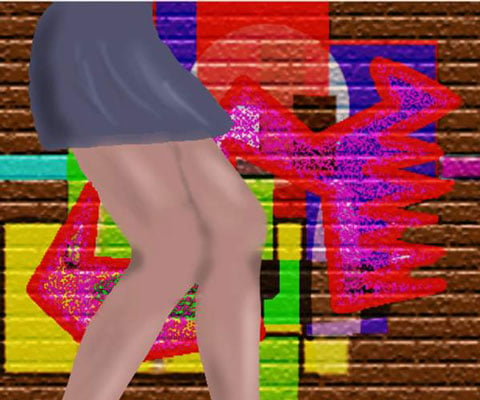Art History Brush Tool Color Not Working in Photoshop 70

In addition to painting landscapes and portraits (which you certainly can exercise in Photoshop, if you take the talent and training), you tin use Photoshop'due south painting tools for a variety of other tasks. For example, you can paint to create masks and layer masks, adjust tonality or sharpness in specific areas, repair blemishes and other damage in an epitome — even to create graphic elements and special effects.
Add together colour with the Pencil tool
The Pencil tool differs from the Brush tool in 1 major respect: Regardless of the Hardness setting in the Brush panel, the Pencil tool always uses a hardness value of 100%.With the Pencil tool agile, the Options bar offers the miniature Brush panel, a choice of blending mode and opacity, the somewhat-misnamed Auto Erase option, and a symmetry option, which enables y'all to mirror your pencil stroke with one of several presets such as Vertical, Horizontal, Wavy and much more.
When you choose the Symmetry choice, you cull a preset, then suit it to create the blazon of symmetry you need for the lines you're drawing with the Pencil tool.
When selected, Auto Erase doesn't actually erase, just rather lets you paint over areas of the current foreground color using the current background color. Click an area of the foreground colour, and the Pencil applies the background color. Click whatever colour other than the foreground color, and the Pencil applies the foreground color.
Remove color with the Eraser tool
The quaternary of your primary painting tools is the Eraser. On a layer that supports transparency, the Eraser tool makes the pixels transparent. On a layer named Background, the Eraser paints with the background colour.On the Options bar, the Eraser tool's Mode menu doesn't offer blending modes, but rather three beliefs choices. When yous select Brush (the default), the Options bar offers yous the same Opacity, Period, and Airbrush options as the Brush tool. You can also select Pencil, which offers an Opacity slider, but no Catamenia or Airbrush option (comparable to the actual Pencil tool).
When Way is set to Block, you have a square Eraser tool that erases at the size of the cursor. (When you click or elevate, the number of pixels erased is tied to the current zoom gene.)
Regardless of which mode is selected, the Options bar offers i more than important selection: To the correct of the Airbrush button, you'll find the Erase to History check box. When selected, the Eraser tool paints over the pixels like the History Brush, restoring the pixels to their advent at the selected land in the History panel.
A couple of variations on the Eraser tool are tucked away with it in the Toolbox, also. The Background Eraser tool tin can, in fact, be used to remove a background from your image. Nonetheless, it'southward not limited to something in your epitome that appears to exist a background.
Recall that digital images don't really take backgrounds and foregrounds or subjects — they just have collections of tiny, colored squares. What does this mean for using the Background Eraser? You tin can click and drag on any color in the image to erase areas of that color. You can likewise elect to erase only the electric current background colour and designate the foreground colour every bit protected so that it won't be erased even if you drag over it.
The Magic Eraser, like the Magic Wand choice tool, isn't a castor-using tool, only this is a logical place to tell you nigh it. Click a color with the Magic Eraser tool, and that color is erased, either in a contiguous area or throughout the image, depending on whether you have selected the Face-to-face option in the Options bar.
And, like the Magic Wand, you can prepare the tool to piece of work on the active layer or all layers in the Options bar, and you can also set a specific level of sensitivity (Tolerance). Hither is the one difference between the 2: The Magic Eraser is, in fact, a painting tool in that you can set an opacity percentage, which partially erases the selected pixels.
Source: https://www.dummies.com/article/technology/software/adobe-products/photoshop/add-or-remove-color-in-photoshop-cc-164346/

0 Response to "Art History Brush Tool Color Not Working in Photoshop 70"
Post a Comment